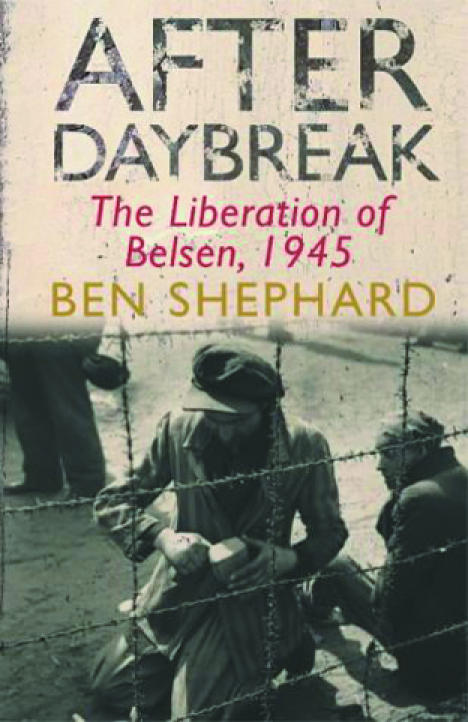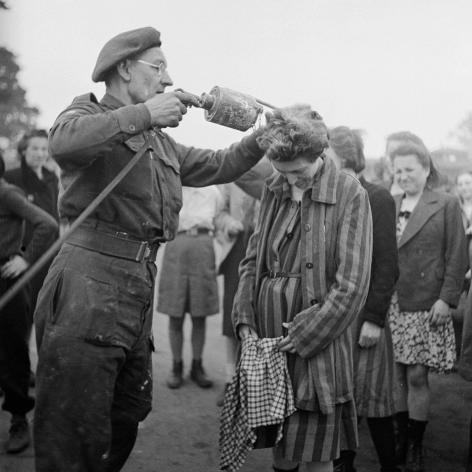Sixty years ago, on 15 April 1945, British soldiers of the 63rd Anti-Tank Regiment entered the Bergen-Belsen concentration camp near Celle in northwest Germany. What they found sent shockwaves around the world. At first they came upon apathetic scarecrows in filthy, striped prison rags, sitting in their own excreta, so emaciated that it was difficult to tell women from men, living from dead. Then, as word spread, the soldiers were mobbed by wailing, stick-like figures, struggling frantically for help. The dusty barren ground was littered with piles of unburied corpses.
Figure 1.

Ben Shephard
Jonathan Cape, £17.99, pp 292 ISBN 0 224 07355 9
Rating: ★★★⋆
Worse was to come. A camp that had been built to house 7000 “elite” Jews to be used as bargaining counters had swollen to more than 40 000, as others were evacuated in advance of the Russians. More than a hundred huts measuring 90 by 30 metres and built to hold at most 50 to 80 people now housed an average of 500 sick, dying, or dead people; in one hut 400 of the occupants were dead. The stench and the pathetic cries for help were unbearable. Sanitation had long since broken down, and most inmates were too feeble to do other than defecate where they lay. There was no running water, no electricity, scarcely any food—and typhus raged.
That evening Brigadier Glyn Hughes, deputy director of medical services in the 2nd Army, arrived to appraise the situation. He estimated that there were around 28 000 women who were on the whole sicker than the 12 000 men. He thought that 70% of the total number required immediate hospitalisation, and that 10 000 inmates had little chance of survival (in the end this turned out to be 13 000) and that there were 10 000 unburied bodies. Malnutrition, typhus, tuberculosis, sepsis, and universal diarrhoea (probably functional rather than infective) were rife. But the British army was fully committed. Even though it was winning the war it was still encountering stiff resistance, and there was no way of providing the massive resources needed. In the event, two field hygiene units, the 3rd Casualty Clearing Station, and the 11th Light Field Ambulance were deployed. Colonel James Johnston, commander of the ambulance unit and appointed senior medical officer, commented that a dozen general hospitals would be needed to do the job properly.
Figure 2.
Liberated women prisoners from Bergen-Belsen receive a dusting of DDT
Credit: GEORGE RODGER/TIME & LIFE PICTURES/GETTY IMAGES
The task seemed insuperable. A priority, of course, was to provide suitable food. The five camp kitchens were taken over by men of the 113th Light Anti-Aircraft Regiment, but supplies were irregular, and few internees could take solid food. The arrival of 97 students from London medical schools at the beginning of May (of whom I was one) meant that enough people were available to concentrate on the time consuming business of obtaining proper supplies from the kitchens and persuading the sick inmates to take something. They experimented with a famine mixture (too sweet) and protein hydrolysate (too unpleasant) and eventually settled for coaxing the inmates to take frequent small amounts of tea, milk, broth, and soup. At the same time they set about cleaning out the huts.
A laundry was established where inmates were washed and deloused; DDT was used on everyone in the camp and in all the huts to prevent the spread of typhus. It took 13 days for the anti-aircraft regiment, using bulldozers, to bury the dead in mass graves. A plan to move the sick people to the huge and luxurious Panzer Training School half a mile away, where there were already 15 000 recently arrived male internees, stalled because of organisational difficulties and insufficient equipment, but the original camp was finally destroyed on 21 May, by which time 17 000 inmates had been discharged physically well and 14 000 had been moved up the road into what had the dubious distinction of being the largest hospital in Europe.
Since then a forbiddingly large archive of official documents and personal testaments has accumulated, and Ben Shephard, author of an admired history of military psychiatry, has done a splendid job in After Daybreak, sifting through all this for today's reader. Not only has he produced a vivid, blow by blow account of the tragedy, as told largely by the players, but he takes full account of the historical context and especially the long term outcomes. But I have two small caveats. Unfortunately he subscribes to the fashionable, revisionist view of history that has to find fault (“big mistakes,” he calls them) in past actions. I wonder whether famine relief in present day Africa is organised any better. Secondly, in his understandable sympathy for the fate of the Jews, he fails to emphasise that just under half the inmates were non-Jewish nationals from every country in Europe and Scandinavia; their different languages and cultures added immeasurably to problems of management. But to end on a brighter note: the available evidence indicates that permanent traumatisation as a result of their experience at Belsen was the exception rather than the rule among inmates and their carers.
Competing interest: AP was one of the medical students who went to Bergen-Belsen, and he lent his diary to the book's author.



